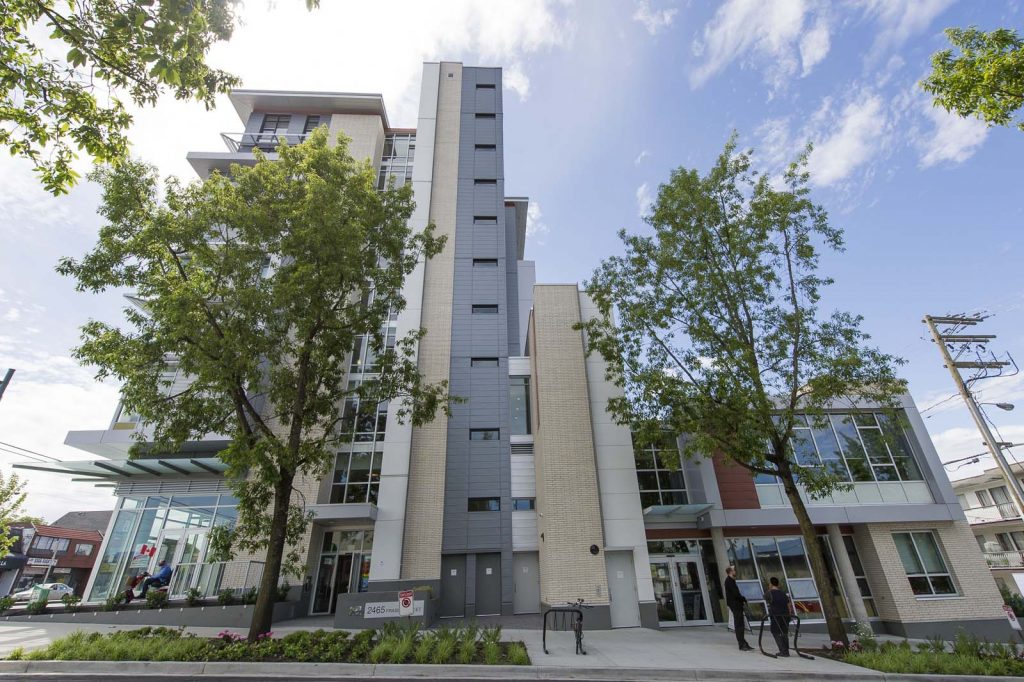Broadway Youth Resource Centre & Kwayatsut Housing
Case Studies / Space profiles

Broadway Youth Resource Centre & Kwayatsut Housing
Space Profile
- Space/Facility Name: Broadway Youth Resource Centre (BYRC) and Kwayatsut
- Name of the Tenant: Pacific Community Resources Society (PCRS) and Vancouver Native Housing Society (VNHS)
- Society Mission – PCRS: Inspiring healthy and inclusive communities through leadership and collaboration.
- Society Mission – VNHS: Vancouver Native Housing Society’s mission is to provide safe, secure and affordable housing for low income Indigenous and non-Indigenous individuals and families in Vancouver.
- Organizational Type - VNHS: Registered charity and non-profit
- Organizational Type - PCRS: Registered charity and non-profit
- Owner – Land: City of Vancouver
- Owner – Building/Improvements: BC Housing owns the building, and VNHS is responsible for tenant improvements
- Rent/Lease/Own: Vancouver Native Housing Society holds a head lease from the City, and Pacific Community Resource Society sub-leases the BYRC from them
- Address: 2455 Fraser St, Vancouver, BC V5T 0E5
- Square Footage/ Size: BYRC is 15,000 sf, and Kwayatsut is 103 units
- Year Opened: BYRC originally opened in 1999, Kwayatsut and the redeveloped BYRC opened in November 2014
- Space/Facility Type: community facility, multi-purpose, non-market residential
- Programs/Services:
- PCRS partners with a number of community, health, social service, and educational organizations at the BYRC to deliver a wide range of programs and services for youth aged 13 to 25. These include mentorship, leadership, and skills programs; high school education through an alternative school; and counselling, housing, food, and medical services. BYRC gives youth access to basic needs such as showers, laundry, and food, and access to other PCRS services including substance use support, the Vancouver Youth Housing Program to support youth at risk of homelessness, the Youth to Adult Transition Program to support youth transitioning from foster care to independence, SHIFT Employment Program to help youth develop culinary skills for employment, and a number of youth and family support programs.
- VNHS manages Kwayatsut, which includes 103 supportive housing units. Thirty of these units are operated collaboratively with PCRS, and are designated for youth, with 10 each reserved for LGBTQ2S+ youth, Indigenous youth, and youth in government care.
- Website – PCRS: https://pcrs.ca/
- Website – VNHS: https://vnhs.ca/
Case Study
Synopsis
Concept & Need
Partnerships & People
Planning, Feasibility, Acquisition & (Re)Development
Business Models & Operations
Funding & Financing
Impact & Lessons Learned
Synopsis
Pacific Community Resources Society has operated the Broadway Youth Resource Centre (BYRC) on the corner of Broadway and Fraser in Vancouver since 1999, providing a wide range of services to at risk youth and youth experiencing homelessness. The City of Vancouver bought the site to preserve it for the BYRC in 2007 and in 2011, the City, in partnership with BC Housing, identified it as one of 14 City-owned sites they would redevelop in order to increase the number of social housing units in the city, while preserving BYRC on the site. Between 2011 and 2014, the site was redeveloped to include a new, purpose-built space for BYRC, and 100 units of social housing, which included 30 units for youth. The Youth Resource Centre includes a medical clinic, counselling services, an alternative school, a commercial kitchen, and access to basic services like showers and laundry for youth in the community—all in a purpose-built space. The housing side of the site is operated by Vancouver Native Housing Society, in a partnership created to enable and support the redevelopment. BYRC and Kwayatsut are an inspiring example of multiple levels of government coming together with established non-profit organizations to create a truly collaborative, multi-faceted model for service and program delivery for at risk youth and those experiencing homelessness.
Concept & Need
 Kwayatsut and BYRC, as seen from Fraser Street. Photo Credit: BC Housing
Kwayatsut and BYRC, as seen from Fraser Street. Photo Credit: BC Housing
“The concept/idea of the BYRC is an ‘ungated,’ accessible one stop service hub, including attached housing, targeting local Mt. Pleasant / Midtown Vancouver youth with barriers (and of course endless potential), in order to keep our local young people from drifting to the Downtown Eastside, which can become a one way street.” – Ingrid Kastens, former CEO, PCRS
The Broadway Youth Resource Centre (BYRC) first opened its doors at the corner of Fraser and Broadway in Vancouver in 1999. Its opening represented the culmination of a partnership between British Columbia’s Ministry of Child and Family Development (MCFD), the City of Vancouver, and Pacific Community Resources (then called Nisha Children’s Society). In the late 1990s, MCFD was restructuring a number of its contracts, and was looking for ways to improve service delivery for youth through collaboration and colocation.
MCFD, the City, and Nisha were aware of the issues facing a growing number of youth in Vancouver’s Mt. Pleasant neighbourhood. The neighbourhood’s demographics were made up of many renters, low-income households, newcomers to Canada, and a large population of vulnerable youth who had nowhere to go to access the services they needed. Once the space at Fraser and Broadway, then run by a private landlord, had been identified and leased, the result was the first BYRC, envisioned as a one-stop shop for youth ages 16 to 24 to access multiple services. The space, one of six commercial rental units (CRUs) on the site, was 7,005 square feet in size, and offered services including healthcare, alternative schools, and basic needs such as laundry, showers, and food. BYRC was one of four youth hubs created across Vancouver by this intergovernmental initiative around the same time.
“Lots of youth were not accessing some of the more traditional places where youth could go like community centres. A lot of them were a little bit older so they weren’t welcome in places like the Boys and Girls club because they were over 18 or 19, so there just was really nowhere for these young people to go, so that’s where the idea of having a youth hub really [came from]… It was a combination of need for the youth community and an interest from funders, particularly the Ministry of Child and Family Development, to create these hubs where they could co-locate and have multiple services operating in a one-stop shop,” – Debbie Anderson Eng, CEO, PCRS
Roughly a decade after it opened, the BYRC’s landlord decided to sell the property. Seeing this as an opportunity to secure the site, then manager of BYRC Robert Wilmot approached the City of Vancouver about the possibility of them buying the site to preserve it for BYRC in perpetuity. The request came to Debbie Anderson Eng, who was then a Senior Planner at the City. Anderson Eng instigated the internal discussions that resulted in the City buying the site, ensuring that PCRS could continue to run BYRC there.
A few years later, the City once again partnered with the provincial government, although this time through BC Housing, to tackle the growing challenges around homelessness in the province. Part of the impetus for the partnership at the time was the 2010 Olympics, which created an opportunity for the City to showcase their approach to housing vulnerable people to the world. They identified 14 City-owned sites to redevelop in order to provide supportive and affordable rental housing, of which the BYRC site was one. The plan was to redevelop the site to create a purpose-built space for the BYRC, while adding 103 units of affordable housing and several CRUs along Broadway. In order to do this, the City facilitated the creation of a partnership between PCRS and Vancouver Native Housing Society (VNHS), as PCRS had little experience operating housing directly at the time, and the two organizations had worked together successfully in the past.
“We house members of the urban Indigenous population, Broadway Youth’s clientele was at least 50%, and I think close to 60%, Indigenous. We have buildings for seniors, we have buildings for families, and we have building specifically for women, and one of the groups we didn’t have a building for was youth, and so this really helped fulfil our mandate on the youth end of things.” – David Eddy, CEO, VNHS
The newly purpose-built BYRC opened in November 2014, along with the attached housing, Kwayatsut. As a PCRS program site, BYRC clearly reflects PCRS’s values and mission of “inspiring healthy and inclusive communities through leadership and collaboration.”[1] In terms of strategic direction, the BYRC site’s earlier purchase by the City and subsequent redevelopment also aligned well with PCRS’s interest in either owning or more directly managing their spaces moving forward. The addition of social housing units and the partnership with VNHS allowed PCRS to offer safe, secure housing to their program participants, representing an expansion of the on-site support they are able to provide. Prior to the redevelopment, the PCRS Housing and Transition Programs team helped youth secure housing in the private rental market. This had always been difficult to achieve with highly variable levels of quality in the private stock and increasing issues of affordability as the cost of living in Vancouver began to soar. The partnership with VNHS was the beginning of PCRS being able to offer secure housing directly to their clients. This was matched with VNHS’s mission to “provide safe, secure and affordable housing for low income Indigenous and non-Indigenous individuals and families in Vancouver.” Together PCRS and VNHS added tremendous value to the city’s social services and housing stock with the 103 units at Kwayatsut and the new Broadway Youth Resource Centre.
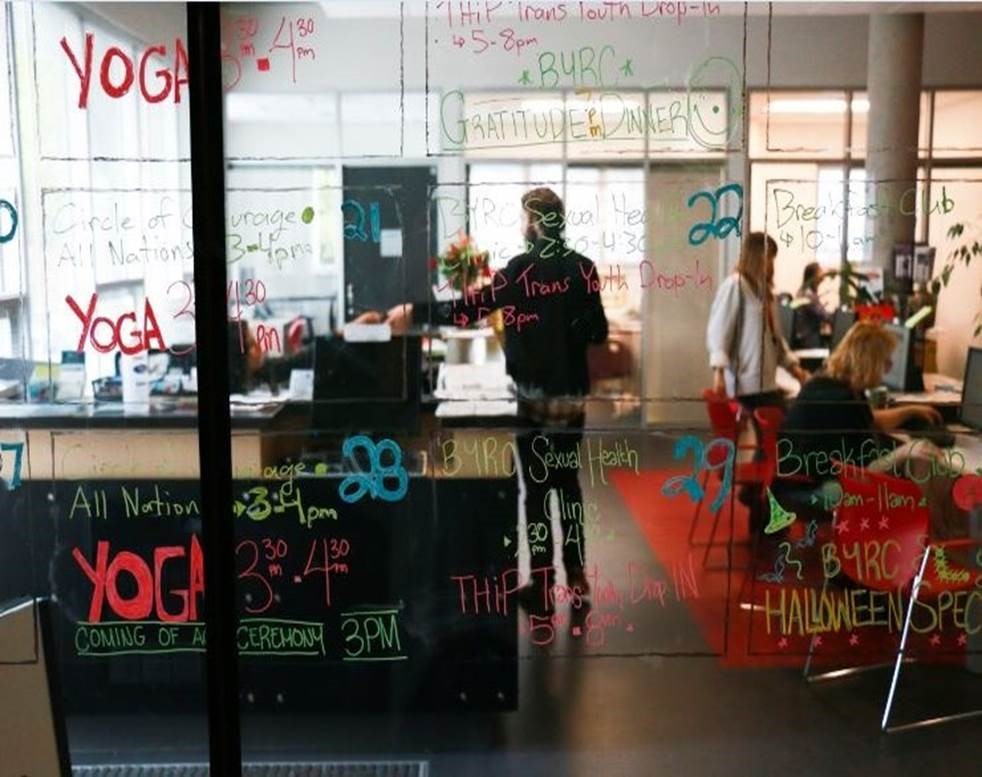 BYRC Reception and Resource Room. Photo Credit: PCRS
BYRC Reception and Resource Room. Photo Credit: PCRS
Partnerships & People
Throughout BYRC’s over-20-year history, a number of people and organizations have been involved. In its current form, the two major players organizationally are Pacific Community Resources Society and Vancouver Native Housing Society, who operate the Broadway Youth Resource Centre and Kwayatsut respectively. The Ministry of Child and Family Development were a major funder of the original BYRC’s creation and continue to provide the majority of the staffing dollars required to operate. BC Housing largely funded the redevelopment and the housing operations, and the City of Vancouver has also been a key partner, as the owner of the site.
“Well, there’s a number of stars that had to align for this to happen, and one of them was the partnership to be created on this particular building… The site was owned by the City of Vancouver and [they made it] available… to BC Housing, as sites where social housing and other social purpose real estate could be built, so because BYRC were there originally and they had this great relationship with the City and they needed a social housing partner to make their housing work, and because they’d worked with us in the past we had a great relationship with them, they asked us if we would partner with them and we said yes. We needed all those things to put it together.” – David Eddy, CEO, VNHS
On an individual level, Ingrid Kastens, past Executive Director and CEO of PCRS championed the project from the BYRC side, and David Eddy, CEO of VNHS, was an equal champion of the project from the Kwayatsut side. Debbie Anderson Eng worked in her role at the City of Vancouver to help establish the original BYRC in 1999, then again with the City’s purchase of the site. She is now PCRS’s CEO. Leading up to the site’s redevelopment, BYRC’s manager Robert Wilmot was a champion of the project and the key contact person in setting up the partnership with VNHS. During the redevelopment, Jocelyn Helland took over as manager of the BYRC, and her clear vision for the space has had a lasting impact on its ultimate layout and use.
Other key players in BYRC are the organizations PCRS partners with to provide services. As the diverse services it provides are central to the BYRC’s purpose, the organizations that work together to provide them are invaluable. These organizations and programs include:
- The Vancouver School Board, in partnership with PCRS and Vancouver Coastal Health, operates the East Van Education Centre at BYRC. The East Van Education Centre is an alternative school that offers a supportive environment with a high staff-to-student ratio for students working to complete Grades 8-12 who experience difficulties in a regular school environment.[2]
- Vancouver Community College operates their Adult Basic Education Program out of the BYRC, which helps youth 15-18 complete Grade 10, and certain Grades 11 and 12 courses, in a supportive learning environment.[3]
- Vancouver Coastal Health operates a Youth Clinic that provides free, drop-in services provided by trained health care professionals to address sexual health, contraception, and general counselling; a primary health youth clinic; and a Substance Use Day Treatment program out of BYRC.[4]
- Leave Out ViolencE (LOVE) BC runs youth-driven, arts and skills-based programs to end the cycle of violence experienced by youth. To achieve this, LOVE BC works with youth to build their emotional intelligence and leadership skills through strong relationships. The programs they offer at BYRC include a weekly art drop-in night, a leadership program, and special events like art shows.[5]
- Check Your Head is a non-profit that works to educate, activate, and empower youth to create change and get involved in community movements through opportunities including workshops, mentorship, and leadership skills training. Their administration and programs are based out of BYRC.[6]
- City University of Seattle in Canada (CityU) is a not-for-profit post-secondary institution that operates the City University Community Clinic at BYRC, where Master of Counselling students provide free counselling to youth. CityU has been partnering with BYRC since it first opened in 1999.[7]
- Other partners in BYRC include Boys & Girls Clubs of Canada, Urban Native Youth Association, Adler University, Aunt Leah’s Place, Vancouver Aboriginal Children and Family Services, and Mount Pleasant Neighbourhood House (MPNH).[8]
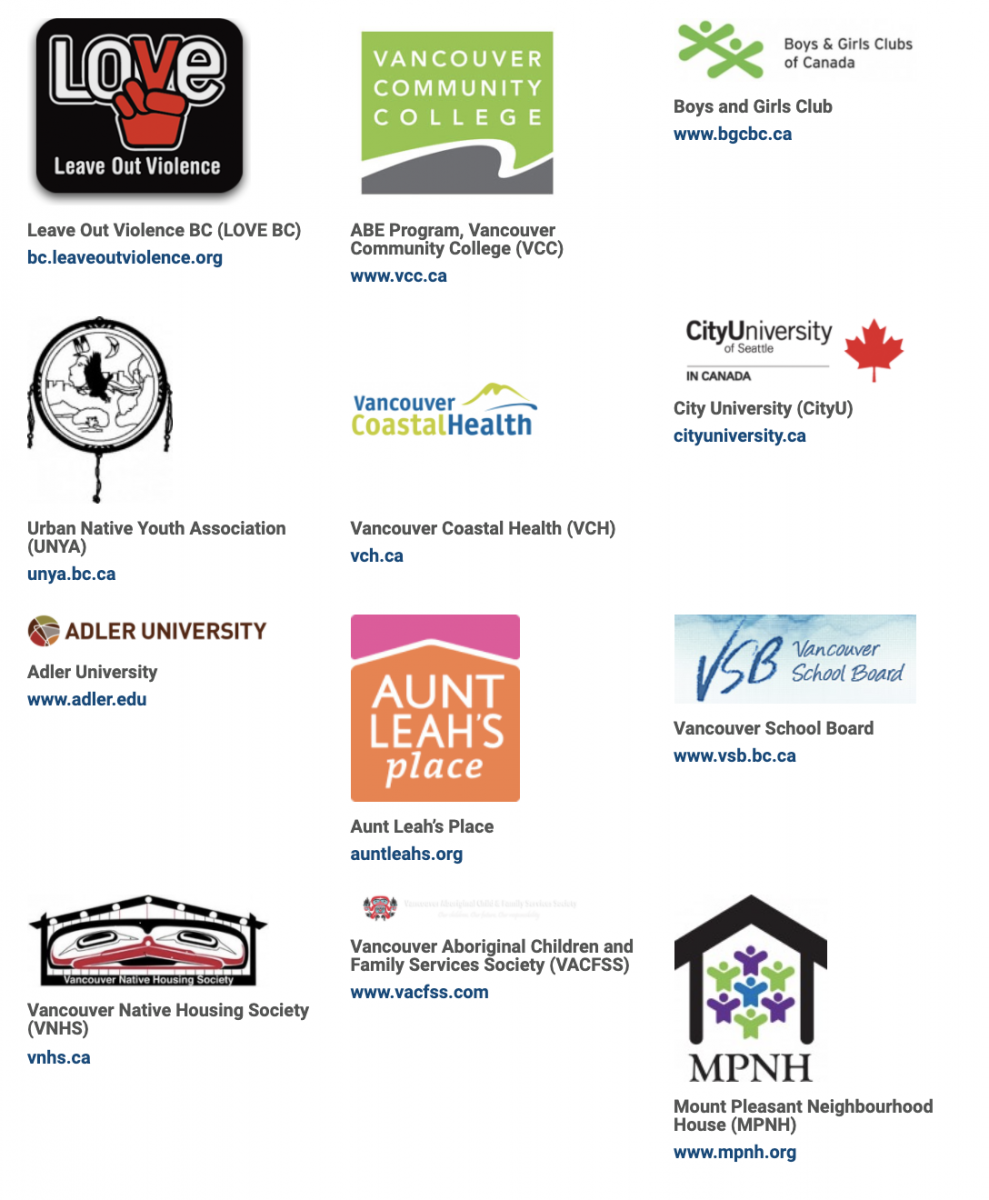 Logos of the Partners involved in BYRC. Source: pcrs.ca
Logos of the Partners involved in BYRC. Source: pcrs.ca
Planning, Feasibility, Acquisition & (Re)Development
“In many ways the history/reputation/everything we had done to date over the prior decade since opening the Broadway Youth Centre was part of the "timeline"/reason we were able get support for our SPRE project.” – Ingrid Kastens, former CEO, PCRS
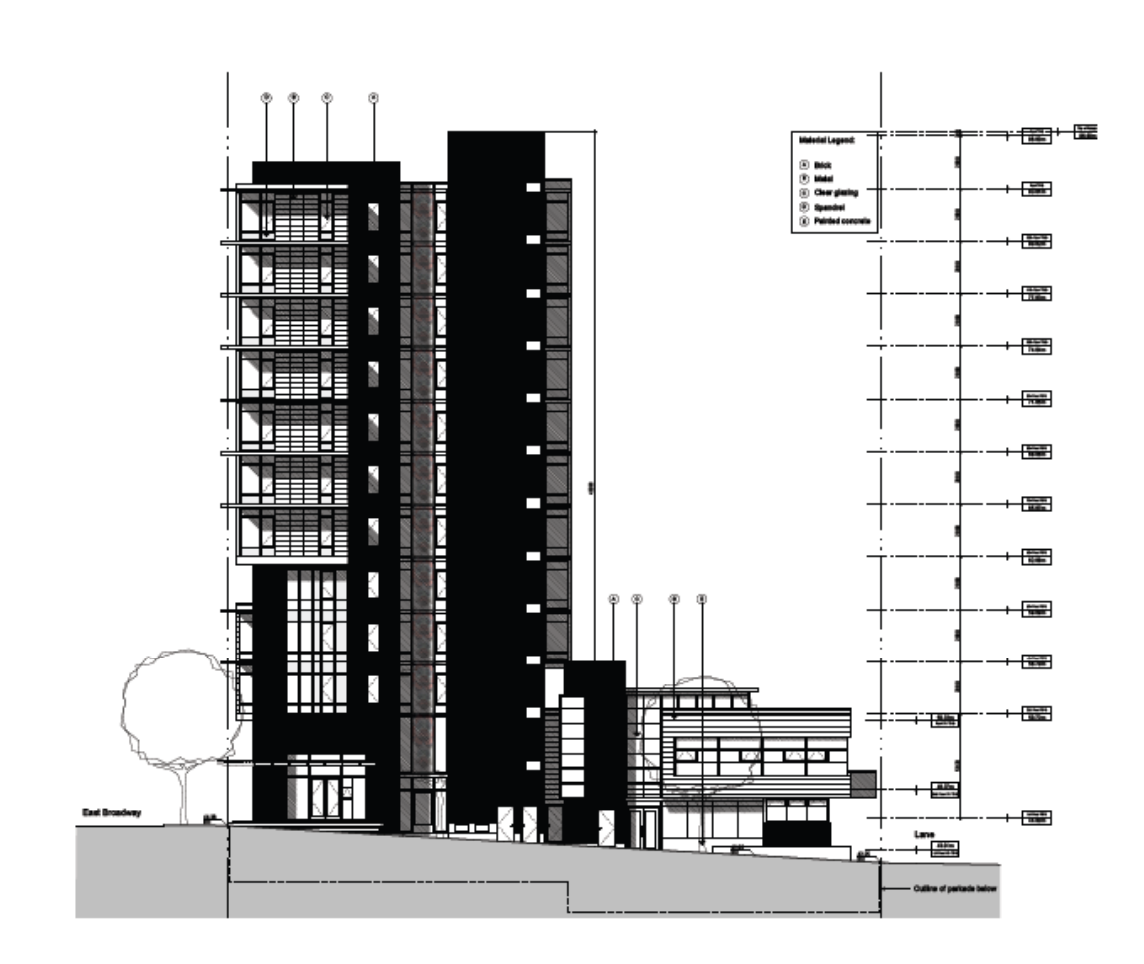 Fraser Street Elevation. Photo Credit: City of Vancouver [9]
Fraser Street Elevation. Photo Credit: City of Vancouver [9]
Timeline
- Concept/Idea of original BYRC: mid-late 1990s
- Original BYRC Opens: 1999
- Concept/Idea of Supportive Housing Sites at the City: 2007
- City of Vancouver buys the BYRC site: 2007[10]
- City Sites Identified for Supportive Housing Developments: 2011
- PCRS moves youth resource centre services to temporary site: 2011
- Demolition and Development: 2012-2014
- Move-In to BYRC and Kwayatsut: November/December 2014
Generally, in social purpose real estate projects, owners and operators—be they not-for-profit, government, or a mix including private sector—will undertake a variety of feasibility analyses before redevelopment. However, because BYRC was a well-established program, run by a long-standing, successful organization (PCRS was founded in 1984), and because the non-market housing partner, VNHS, was also a long-standing, successful provider/operator, no feasibility studies were deemed necessary for the redevelopment. The need for both the BYRC and housing programs were clearly evidenced through their prior operations. In addition, the City of Vancouver had done significant research into tackling homelessness,[11] through their 2007 Supportive Housing Strategy, and understood the need for sites like Kwayatsut and the BYRC. The fact that PCRS had ongoing operating dollars secured and committed contributed to getting funders on board with the project.
With regards to community engagement, prior to the original BYRC’s establishment, 100 residents, youth and parents helped create a vision document which guided BYRC for its first decade of operation. During the redevelopment, public hearings were held, and at that time some community opposition emerged. However, since the Centre had already been operating in the neighbourhood for over a decade, by the time the redevelopment occurred, the main concern of nearby residents was really only the height of the Kwayatsut residential tower, which was decreased by two storeys as a result.
“There was very little pushback about there being a youth centre there because the youth centre had already been there for at least a decade and had operated really well in collaboration with the local neighbours and businesses, so it wasn’t a concern about the youth, it was concern about the building form and scale.” – Debbie Anderson Eng, CEO, PCRS
Once BYRC opened in 2014, a Community Advisory Committee was established to resolve possible issues. Made up of half community members and half BYRC partner organizations, the Committee met over the first few years with decreasing frequency. As issues did not emerge, existing tensions dissipated, and the Committee has now disbanded.
“That’s been probably the biggest victory of all of this is that it’s really been a shining example of how bringing in this kind of purpose-built site for people who are at risk or people who are dealing with all sorts of issues that surround homelessness don’t bring negative things to the community in terms of impact, in fact housing stabilizes it.” – Calum Scott, Director Operations - Vancouver, PCRS
Business Models & Operations
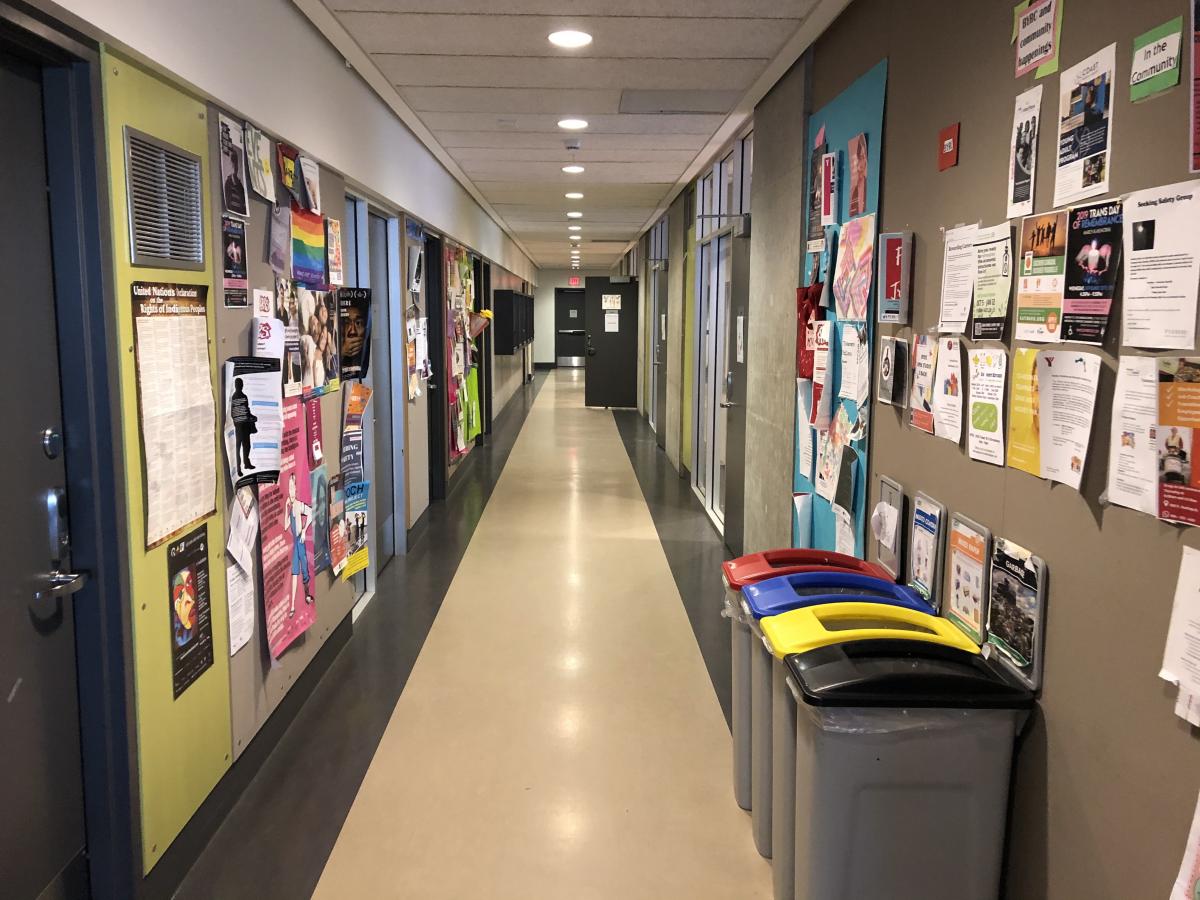 BYRC main floor hallway. Photo Credit: Liana Glass
BYRC main floor hallway. Photo Credit: Liana Glass
Clearly, the idea of partnerships is key to the operational model of BYRC. The City of Vancouver owns the site at Broadway and Fraser, and VNHS holds the head lease for the building. PCRS holds a sublease from VNHS for the BYRC side of the building, and the two organizations have a clear understanding of their joint and separate responsibilities. Within BYRC, PCRS partners with other organizations to provide services. Several of these organizations hold formal memoranda of understanding with PCRS that dictate their terms of use. On the Broadway-facing side of the building, the City of Vancouver manages commercial leases directly, and is careful to select tenants that are suitable to be in proximity to the youth next door.
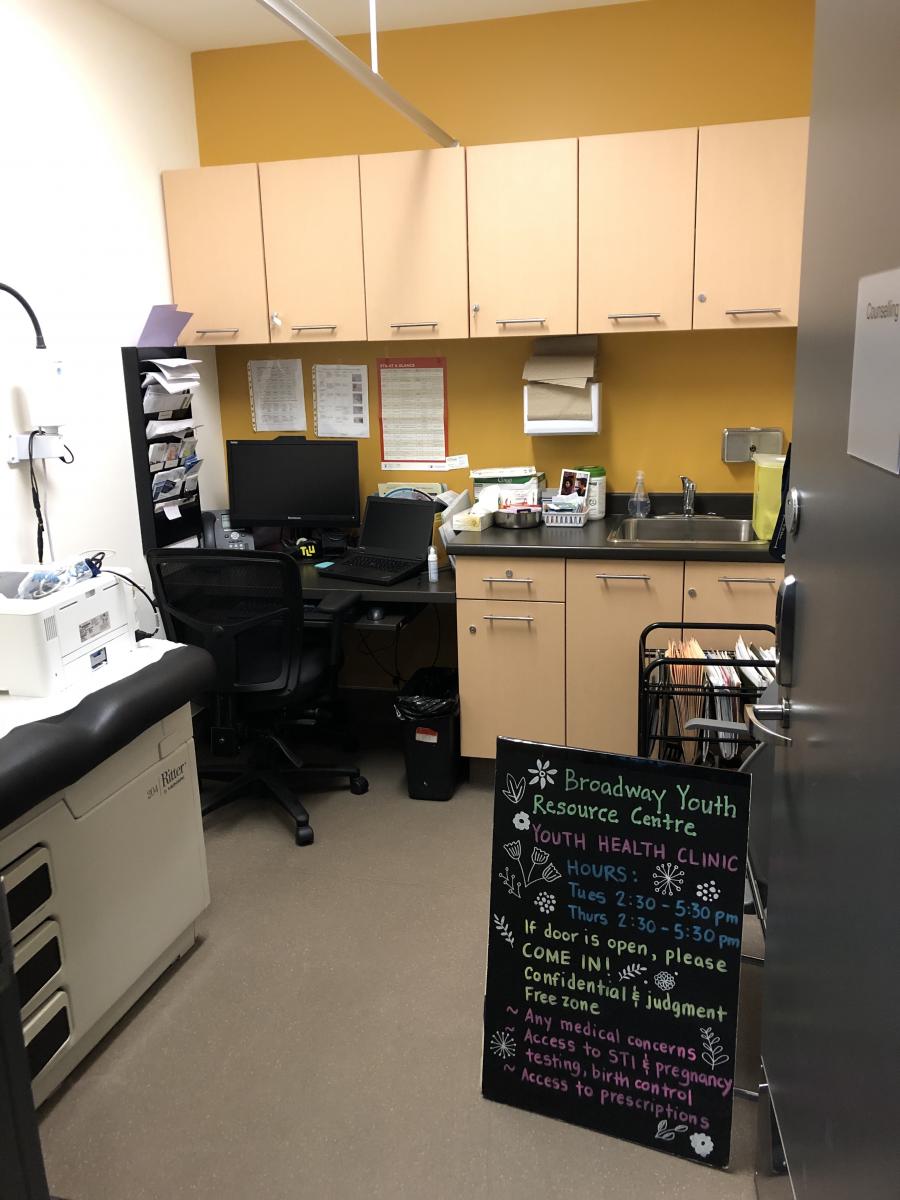 The concept of a youth hub includes access to key services, including the youth primary health care and sexual health clinics (operated in partnership with Vancouver Coastal Health). Photo Credit: Liana Glass
The concept of a youth hub includes access to key services, including the youth primary health care and sexual health clinics (operated in partnership with Vancouver Coastal Health). Photo Credit: Liana Glass
On the main floor of BYRC there are several PCRS administrative and program offices, and a large Resource Room with computers and comfortable seating for youth to come to connect with each other and the available services. There are also administrative spaces for partner organizations, the Youth Health Clinic exam rooms, counselling spaces, a dining room, and a commercial kitchen where the culinary employment skills program takes place. On the second floor, there are a several classrooms for the alternative school operated by VCC and the Vancouver School Board, a staff lunchroom, and several meeting and programming spaces used by the various partner organizations. These organizations and the programs and services they deliver are essential to the BYRC model. On the Kwayatsut side, shared spaces include a large computer lab, a lounge, and a rooftop terrace and garden.
“One of the intangibles of a space like this is for somebody to walk in who’s having a rough day or month or year, to come into a space where they’re being welcomed, and… as they get to understand that this was a space that was built for them, there’s something about that that’s hard to measure, but I have true belief that that does make a difference for people to feel that.” – Calum Scott, Director of Operations - Vancouver, PCRS
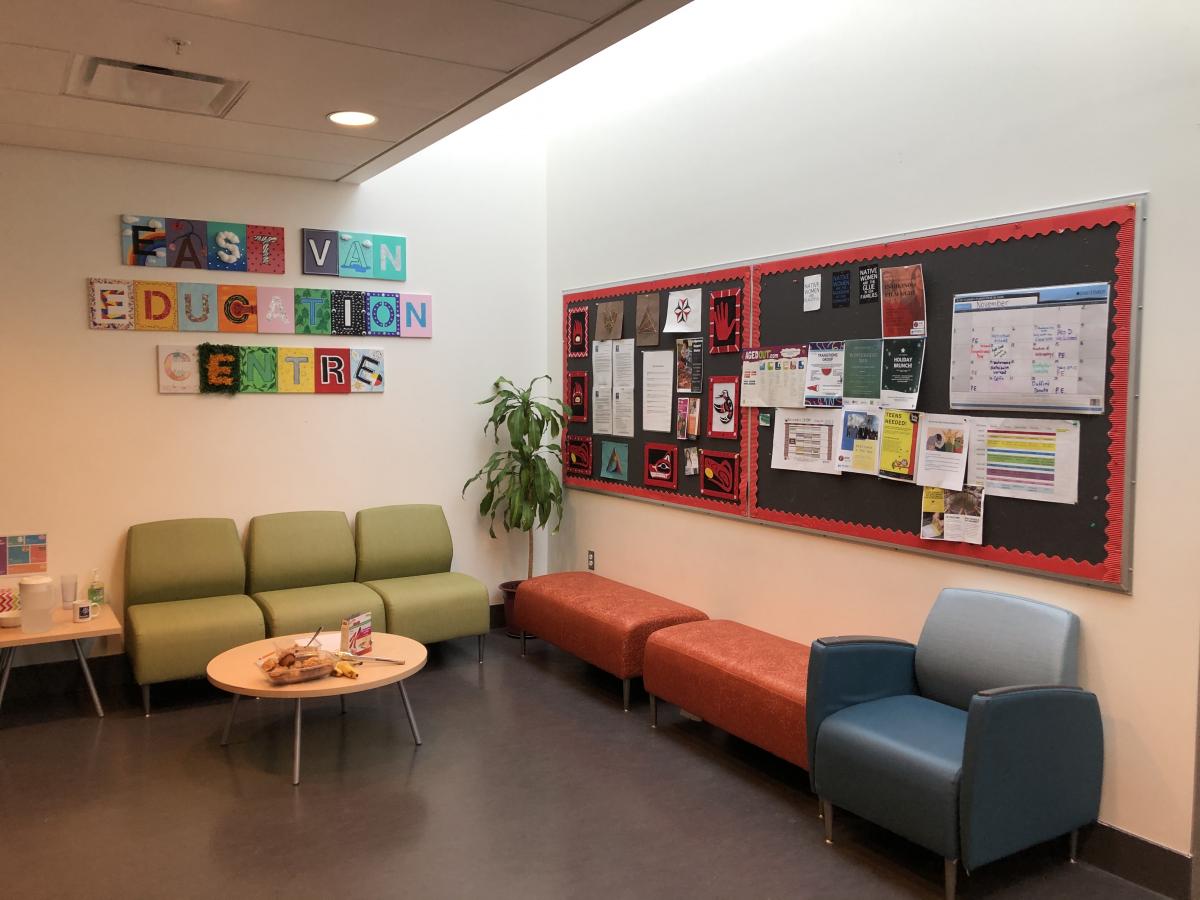 East Van Education Centre reception area. Photo Credit: Liana Glass
East Van Education Centre reception area. Photo Credit: Liana Glass
The Kwayatsut residential tower contains 103 units with the majority of these apartments dedicated to adults from BC Housing’s Supportive Housing Registry. Each of these tenants is identified through a Vulnerability Assessment Test. VNHS is their property manager and landlord. The remaining 30 units in Kwayatsut are designated for youth: 10 for LGBTQ2S+ youth, 10 for Indigenous youth, and 10 for youth in government care. These populations are overrepresented among youth experiencing homelessness. When Kwayatsut and the new BYRC opened, they were the first social housing development in Canada to have units designated specifically for LGBTQ2S+ youth.
Of the 30 youth units, 20 are for youth 19-24 years old. These tenants are selected from PCRS’s Housing waitlist, which the organization updates constantly. The other 10 units are for youth under 19 years of age, and these tenants are referred to PCRS by the Ministry of Child and Family Development and Vancouver Aboriginal Child and Family Services Society. While VNHS is the landlord and property manager for all tenants in Kwayatsut, the youth tenants hold program agreements with PCRS to help them manage this relationship and to provide them support as needed.
“You can’t be doing social service work in Vancouver and not have some at least connection to housing… it’s just such a central piece of the need of the people in Vancouver that you can’t avoid it.” – Zach Batalden, Vancouver Housing and Transition Programs Manager, PCRS
While BYRC is operationally stable and sustainable, PCRS has learned a few lessons and had to fill a few gaps since moving into their purpose-built space. Striking the right balance of funding and staff to take full advantage of the doubled space available to them has been an adjustment for PCRS as they expand and work to optimize the space. A key part of making this work is being able to communicate what is needed operationally, in order to create the best supports possible for the youth using the space, to funders so sufficient levels of funding are provided to hire the people they need. As it currently stands, the average annual operating budget of BYRC is approximately $2.3 million.
One of the adjustments PCRS has had to make as a result of BYRC’s increased size and evolving programming was to the supervisory structure of the Centre. Additionally, they did not receive enough funding immediately after the new site opened to hire enough youth workers. After they had a few years of data on critical incidents in the Centre, they were able to increase the youth worker-to-youth ratio, and the number of incidents dropped immediately. This structure represents an important element of the BYRC: rather than installing cameras to ensure safety, PCRS made the choice to have more staff, and to encourage safety through relationships and connection.
Funding & Financing
A unique element of this redevelopment project is that there was no capital campaign in order for it to be completed. Calum Scott calls it a “shining example” of when different levels of government work effectively together: the City of Vancouver owns the land and has leased it for a nominal pre-paid amount to VNHS and waived property taxes for a 60-year term, BC Housing owns and provided funds for the building, and MCFD funded the building envelope of the Resource Centre side. Ingrid Kastens, formerly of PCRS, emphasizes that this commitment from MCFD took “leadership, creativity and courage” on the part of the Vancouver Coastal Region leader of MCFD. Coast Capital Savings and the Streetohome Society also contributed $20,000 per housing unit to the redevelopment.
Gaining the confidence of funding partners in this manner takes a strong and financially stable partnership. The partnership between PCRS and VNHS, noting their existing, ongoing funding for their own programs, was key to securing funding and managing the redevelopment. PCRS’s commitments of market rent dollars for their program spaces by their various program partners, gave funders further security to commit to the project. It was also essential that the Board of Directors of both organizations fully understood and supported the project.
All capital funds for the project were secured in full, allowing the redevelopment to be completed without loans or debt. The Memoradum of Understanding between the City of Vancouver and BC Housing that led to the redevelopment of the City-owned sites for social housing specified that the City would provide the land and BC Housing would provide the pre-development and construction funds in partnership with other funders [12]. In total, the cost of the BYRC portion of the building was roughly $7.5 million and the total cost of the overall project including the housing was approximately $35 million dollars. BC Housing also committed $18.8 million to BYRC and Kwayatsut longterm operations.
BYRC & Kwayatsut financial summary
Numbers shown are approximate
REVENUE
|
EXPENSES
|
The construction of the Commercial Units within the site cost $4,650,000 and was paid for by the City. As it was not part of the social purpose capital project, it is not included in the lists above.
Impact & Lessons Learned
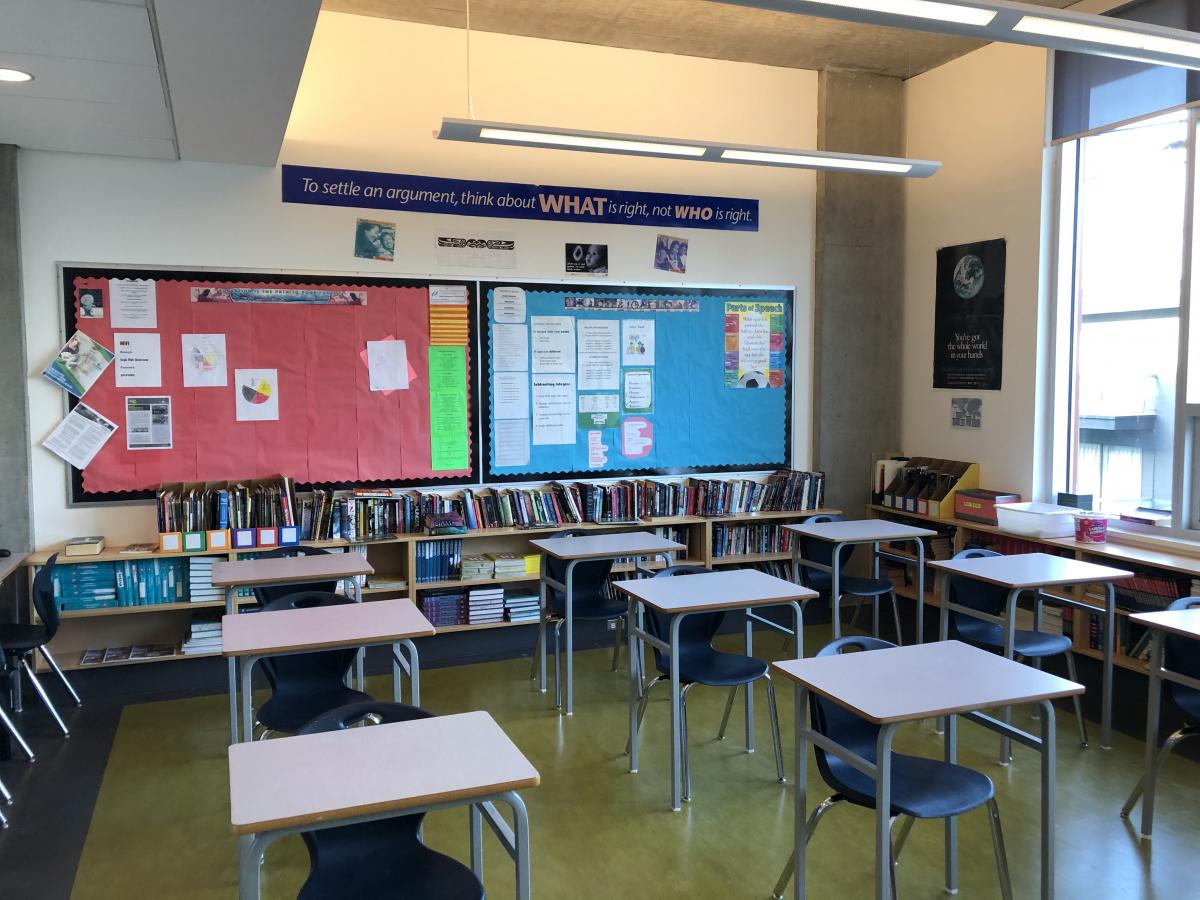 East Van Education Centre Classroom. Photo Credit: Liana Glass
East Van Education Centre Classroom. Photo Credit: Liana Glass
“The redevelopment project enabled the Youth Resource Centre to have a permanent home that was purpose-built for having a youth centre. And it’s a really nice space. A lot of times youth get crappy spaces to have to come to, so this was really providing young people a brand new, very nice space where they could access their health needs, education needs, substance use needs, housing, social, and recreational [needs].” – Debbie Anderson Eng, CEO, PCRS
The Broadway Youth Resource Centre redevelopment project has surpassed the expectations of all those involved. Zach Batalden from PCRS points to the fact that the redevelopment project and the new space opened doors for PCRS and helped them build new partnerships and increased momentum in the sector, saying, “we used to be a tiny player in Vancouver, and we’ve become one of the biggest youth housing providers.” The project has made PCRS a national leader in youth housing and service delivery.
With the facility also providing space for other agencies and community groups to rent after hours, it is achieving both VNHS and PCRS’s goal of being a community hub through all the services they provide. David Eddy of VNHS comments that the space is very welcoming and comfortable, and that the community garden is well used. There is a vibrant community within the building, and the programs and services offered complement each other successfully. Allison Parker, BYRC’s manager, comments that one of the space’s successes is that youth come in “not just as recipients of a service, but real participants in a community space.”
“The intent of this building from PCRS’s end was really about building a purpose-built space for youth where they can be housed and we can provide excellent service… and it’s really inspired positive change in the neighbourhood, which is great.” – Calum Scott, Director of Operations - Vancouver, PCRS
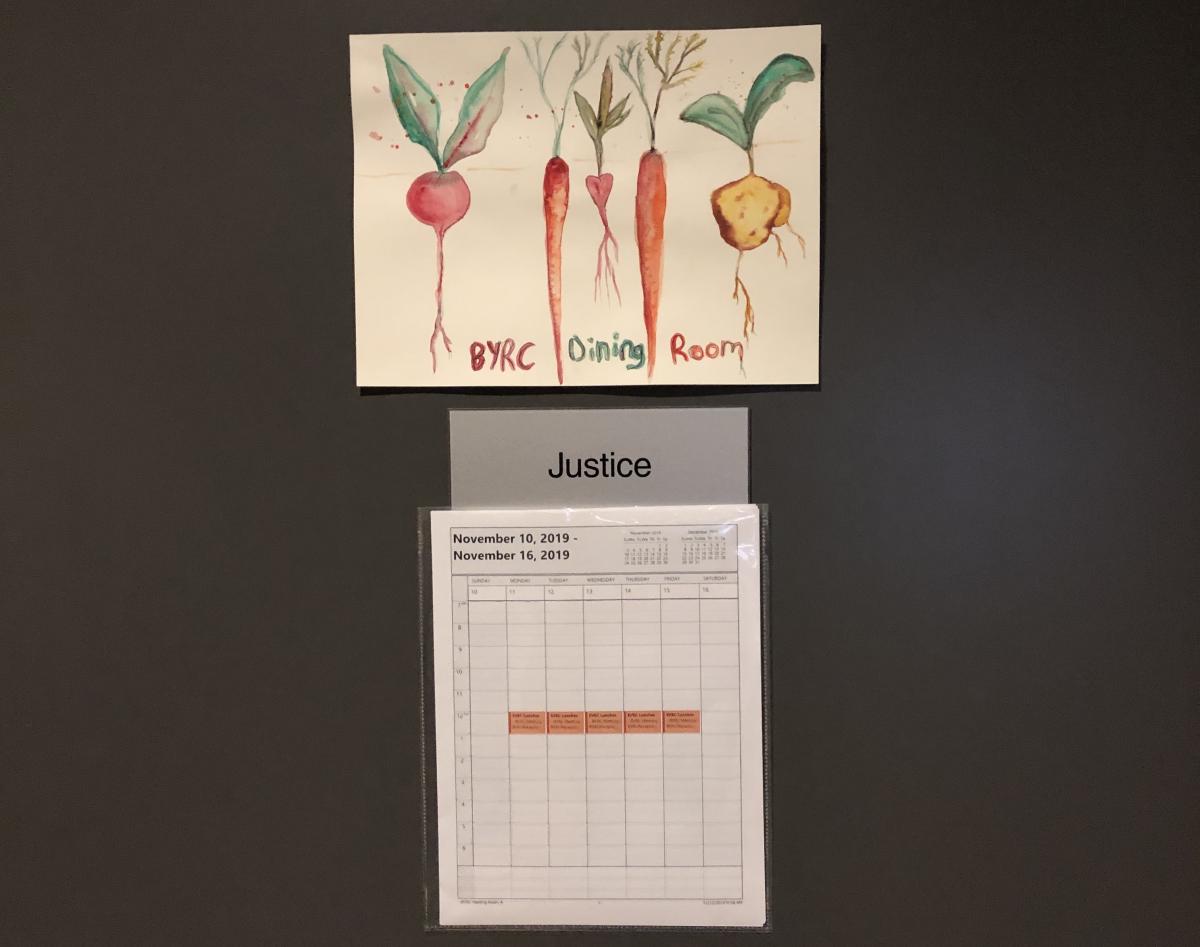 Program spaces at BYRC have names that align with the values of its partner organizations, like this one on the door to the dining room. Photo Credit: Liana Glass
Program spaces at BYRC have names that align with the values of its partner organizations, like this one on the door to the dining room. Photo Credit: Liana Glass
The impact on staff of the new space has been positive as well. For the most part, they do not spend much time thinking about the space: which is an unlikely marker of its success. The purpose-built nature of the building, and its superior quality to the previous space and the temporary one used during the redevelopment, make service delivery and management easy in comparison. Without surprise, there are some operational hiccups. While the site was purpose-built for PCRS’s uses, because it was part of a larger, City-led initiative involving multiple sites, the design process and resulting layout are not as flexible as they might have been otherwise.
“Knowing that we have this space is just one less thing to worry about. The year we were having to worry about moving, or that we might lose our lease, [if we still had to worry about] all those things, it would be a different community.” – Allison Parker, BYRC Manager, PCRS
Perhaps the central takeaway from this project is ensuring the compatibility of partner organizations involved. In such a close partnership, it is essential that the organizations’ values, missions, and visions for the space are well aligned. Ideally, this should be established at the ideation stage, to avoid tensions or conflict down the line. Staff from both VNHS and PCRS highlight the success of their partnership, and the ways it has allowed their organization to grow and learn. Funding partners are also essential, and this project highlights the necessity of having these lined up, and the incredible outcomes possible when major funders are fully on board with a project.
“It really did take many, many partners having that common vision and it took pretty extensive resources to get it done, so having all those resources in place was really important.” – Debbie Anderson Eng, CEO, PCRS
Another major takeaway from the redevelopment of BYRC is around the importance of the intentionality of designing a purpose-built space. This includes gathering feedback from the people it will affect the most: users of the space and the frontline staff delivering services to ensure it will truly meet their needs. This includes understanding the programs that will take place in the space before the design is completed, thus ensuring each is accounted for within the resulting building. Working with design professionals who already have experience with clients in the same field and delivering similar services makes communicating the vision and needs of the space easier and more effective. The design of a space like BYRC also needs to balance beauty and practicality. While top quality features may seem attractive, in some cases they have ended up being too fragile for BYRC’s uses, or very expensive to replace.
In addition to gathering input on what the space needs to include from frontline staff and program participants, Calum Scott, Debbie Anderson Eng, and David Eddy all emphasize the importance of looking to the work done by other organizations to gain inspiration. They advise seeking advice directly and going to visit as many potentially inspiring facilities as possible: there’s no use trying to reinvent the wheel, and there is a lot of knowledge to be gained from others’ experiences.
“Really do [your] homework and understand the process. Be fearless, don’t be intimidated by so many things you could be intimidated by, bureaucracy being one of them. Dream big… Look at it from what it could look like 20 years from now to have created this entity and how many people could be helped along the way, so go forth and really with confidence and assurance that you’re doing the right thing.” – David Eddy, CEO, VNHS
Moving forward and with the knowledge and expertise gained from the Broadway Youth Resource Centre redevelopment, PCRS is planning to develop additional, similar sites. A lot of institutional knowledge was gained through the redevelopment process, including the importance of owning or at least managing land. Since this project occurred, PCRS has acquired several properties, and they are committed to taking this approach forward into their future projects. The services within BYRC will continue to grow and expand, and as Allison Parker puts it, PCRS is now looking to the future to be able to turn what they’ve learned outward, “to continue learning from our projects and to share our learnings and our services whenever we have the opportunity to do that.”
Interviewees:
- Calum Scott: Director of Operations-Vancouver, at Pacific Community Resources Society (PCRS)
- Allison Parker: Manager, Broadway Youth Resource Centre at PCRS
- Zach Batalden: Manager, Vancouver Housing and Transition Programs at PCRS
- David Eddy: CEO of Vancouver Native Housing Society
- Ingrid Kastens: former CEO of PCRS (responses provided to select questions by email)
- Debbie Anderson Eng: current CEO of PCRS, Senior Social Planner at the City of Vancouver at the time of the redevelopment
[2] https://www.vsb.bc.ca/Student_Support/Alternative_Programs/Documents/sbfile/191125/District%20Alt%20Programs%20Resource%20%202019-20%20%20FINAL.pdf
